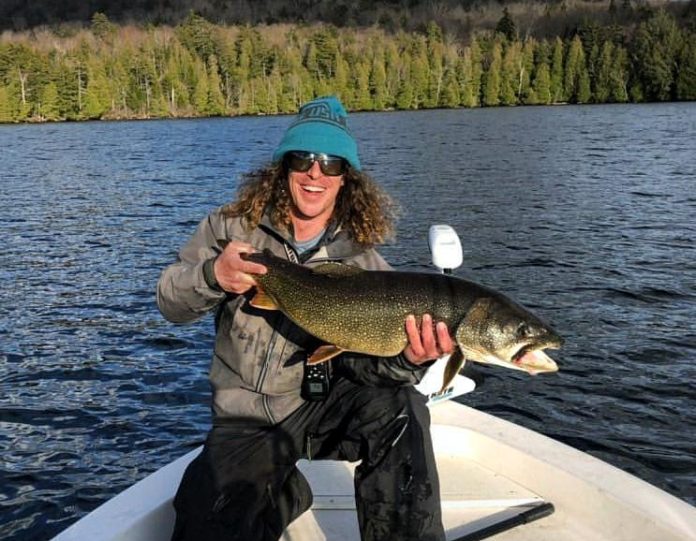SYRACUSE, NY (WRVO) – Zac Horrocks has been an Adirondack-based trout fishing guide for 15 years and he said if there’s ever a year for beginners to try their hand at catching some trout, this is the year.
Zac Horrocks holding a trout that he caught while fishing. ZAC HORROCKS
“I think it’s going to be excellent trout fishing, especially for beginners because the stocked trout are hungry and not too bright,” he said.
Horrocks was referring to the 1.8 million trout that are being stocked into the state’s lakes and streams this year. However, this isn’t any stocking season for the Department of Environmental Conservation–this is the first year of their new 10-year trout stream management plan. The plan went into effect on April 1, the first day of trout fishing season.
After receiving feedback from local anglers, the DEC implemented this new plan which is built around providing higher quality fishing.
“One of the new trout stream management strategies we’re going for is to actually stock larger size trout,” said Jim Everard, an aquatics biologist with the DEC and an avid fisher himself.
He said that not only are the one-year-old trout they’re stocking about an inch bigger than normal, but under the new plan, 10% of the stock are two-year-old trout which average about 12 inches.
“We’re hoping to have all of them 12 inches or bigger with this new policy,” said Everard.
Horrocks holding a trout he caught while fishing. CREDIT ZAC HORROCKS
In addition to stocking bigger brown, brook and rainbow trout, the plan also divides trout streams into five management categories that really split the trout up into wild and stocked. Those categories include what’s called “stock-extended” streams.
These streams are particularly unique in that the department executes a sort of extended-release stocking process. So, let’s say they have 2,000 brown trout. In a normally stocked stream, all of those 2,000 would go in at once, but in a stock-extended stream that number is split up into four intervals of 500 to stagger the stocking throughout the season.
The benefit to this strategy is that people don’t come in at the beginning of the season and catch all the trout leaving the stream dry for fishers later in the season.
There’s one other thing that separates stock-extended streams from the rest. Instead of the standard five trout limit per angler, they’re only allowed to hold three trout from these streams at a time and only one larger one. Everard said this is to the angler’s benefit.
“So by having the limit on the stock extended to three fish with only one over 12 inches, it’s going to keep more fish in the stream … to keep the quality fishing a little better,” he said.
Another huge component to this new plan is that it establishes year-round catch-and-release trout fishing with artificial lures only. However, Horrocks said fishers need to be very careful, even with catch-and-release, about the safety of the fish.
Horrocks posing with a very large trout he caught while out fishing. CREDIT ZAC HORROCKS
“Even if you’re trying to be ethical and fish catch and release, realize that on a hot day, when you get past probably 10 or 11 o’clock in the morning, whether you’re letting fish go and trying to do the right thing or not, you’re probably killing most of the fish that you catch,” said Horrocks.
He said trout are so sensitive to heat that being dragged up into warmer water or being pulled out into the sun can be fatal. He also said that there are downsides to fishing for stocked trout altogether.
“By making a stocked population, you’re making a population that’s dependent on that stocking and on the state versus a wild and natural population in those rivers that used to be sustainable, that whatever toehold they have are getting kind of beat now by this just multitude of stocked fish being dumped into the river and eating eating everything in sight,” said Horrocks.
He said that while stocking trout can have its benefits, it’s definitely throwing a wrench in the local ecosystem.
“It’s good for tourism, and it’s good for the volume of fishing we’re having but it’s somewhat tough on the ecosystem in that it really puts a lot of tax on the food source and it outcompetes the wild fish that have been there and figured out how to make it generation after generation,” said Horrocks.
However, he still has some advice for beginners trying to get their feet wet.
“Giving the trout what they’re normally feeding on is your best chance to catch them,” he said. He also recommended visiting a local fly fishing shop for tips if you’re in an area you’re not familiar with.
Everard recommends that beginners try casting in their driveway or their lawn before taking a stab at casting into a stream, which can often have lots of sticks and logs in it and branches above it. He also recommends just getting out there as much as you can.
“My advice to anybody is go fishing whenever you can, and as often as you can,” he said.
Credit: Source link































